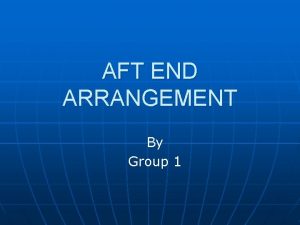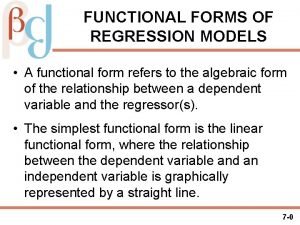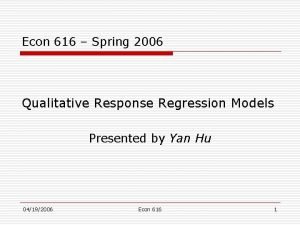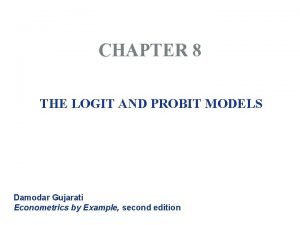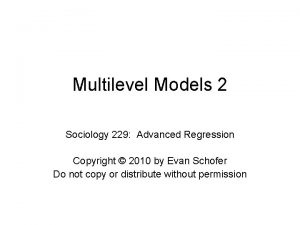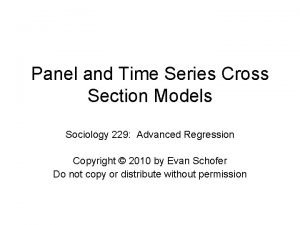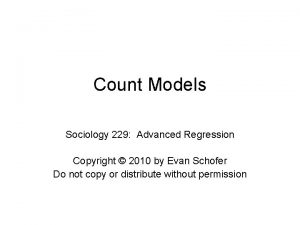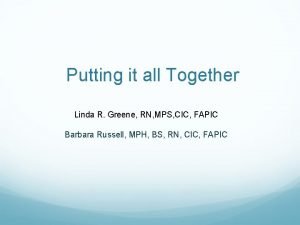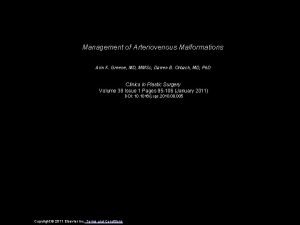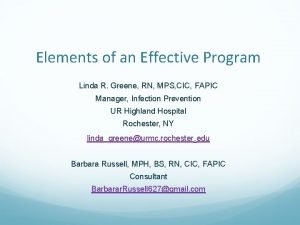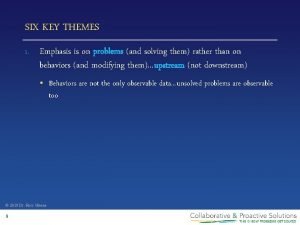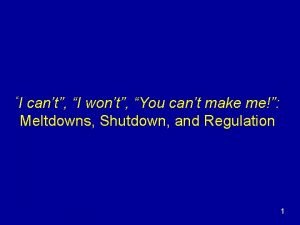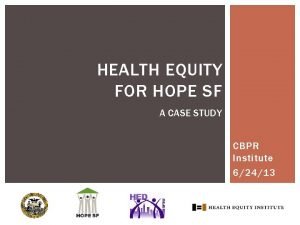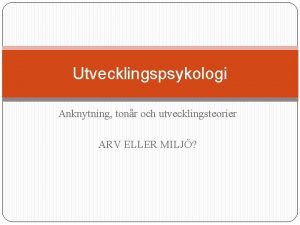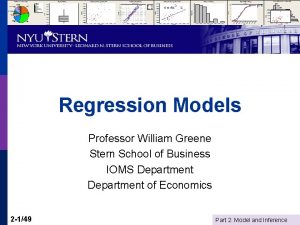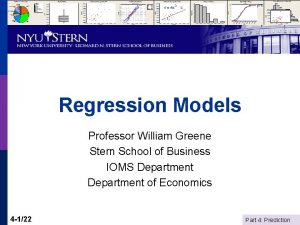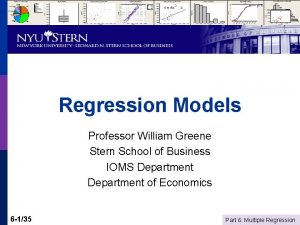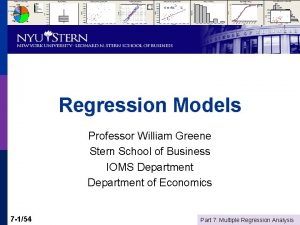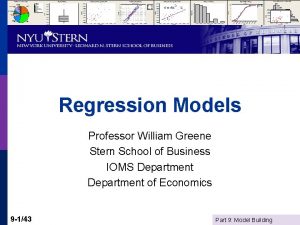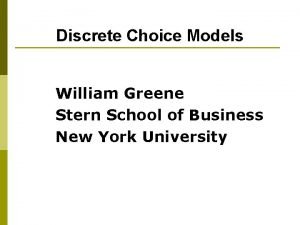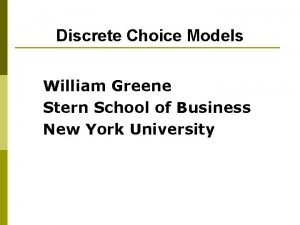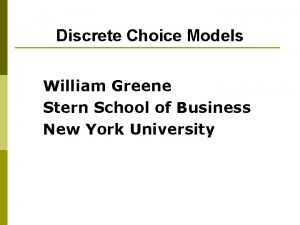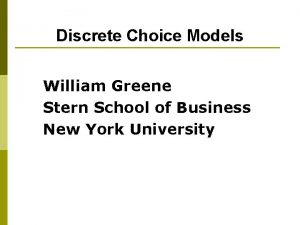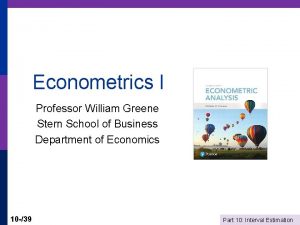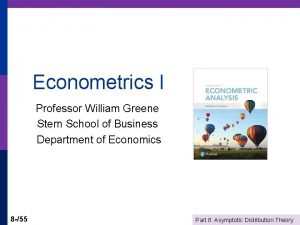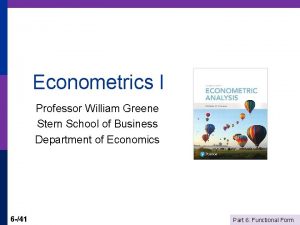Regression Models Professor William Greene Stern School of



































- Slides: 35

Regression Models Professor William Greene Stern School of Business IOMS Department of Economics 8 -1/35 Part 8: Regression Diagnostics

Regression and Forecasting Models Part 8 – Multicollinearity, Diagnostics 8 -2/35 Part 8: Regression Diagnostics

Multiple Regression Models p p Multicollinearity Variable Selection – Finding the “Right Regression” n p 8 -3/35 Stepwise regression Diagnostics and Data Preparation Part 8: Regression Diagnostics

Multicollinearity Enhanced Monet Area Effect Model: Height and Width Effects Log(Price) = β 0 + β 1 log Area + β 2 log Width + β 3 log Height + β 4 Signature + ε What’s wrong with this model? Not a Monet; Sold 4/12/12, $120 M. 8 -4/35 Part 8: Regression Diagnostics

Minitab to the Rescue (? ) 8 -5/35 Part 8: Regression Diagnostics

What’s Wrong with the Model? Enhanced Monet Model: Height and Width Effects Log(Price) = β 0 + β 1 log Height + β 2 log Width + 8 -6/35 β 3 = The effect on log. Price of a change in log. Area while holding log. Height, log. Width and Signature constant. β 3 log Area + It is not possible to vary the area while holding Height and Width constant. β 4 Signature + Area = Width * Height ε For Area to change, one of the other variables must change. Regression requires for it to be possible for the variables to vary independently. Part 8: Regression Diagnostics

Symptoms of Multicollinearity Imprecise estimates p Implausible estimates p Very low significance (possibly with very high R 2) p Big changes in estimates when the sample changes even slightly p 8 -7/35 Part 8: Regression Diagnostics

The Worst Case: Monet Data Enhanced Monet Model: Height and Width Effects Log(Price) = β 0 + β 1 log Height + β 2 log Width + log Height = log Area – log Width β 3 log Area + R 2 in model log Height = a + b 1 log Area + b 2 log Width + b 3 Signed + e will equal 1. 0000000. A perfect fit. a=0. 0, b 1=1. 0, b 2=-1. 0, b 3=0. 0. β 4 Signature + ε What’s wrong with this model? 8 -8/35 Once log Area and log Width are known, log Height contains zero additional information: Part 8: Regression Diagnostics

Gasoline Market Regression Analysis: log. G versus log. Income, log. PG The regression equation is log. G = - 0. 468 + 0. 966 log. Income - 0. 169 log. PG Predictor Coef SE Coef T P Constant -0. 46772 0. 08649 -5. 41 0. 000 log. Income 0. 96595 0. 07529 12. 83 0. 000 log. PG -0. 16949 0. 03865 -4. 38 0. 000 S = 0. 0614287 R-Sq = 93. 6% R-Sq(adj) = 93. 4% Analysis of Variance Source DF SS MS F P Regression 2 2. 7237 1. 3618 360. 90 0. 000 Residual Error 49 0. 1849 0. 0038 Total 51 2. 9086 R 2 = 2. 7237/2. 9086 = 0. 93643 8 -9/35 Part 8: Regression Diagnostics

Gasoline Market Regression Analysis: log. G versus log. Income, log. PG, . . . The regression equation is log. G = - 0. 558 + 1. 29 log. Income - 0. 0280 log. PG - 0. 156 log. PNC + 0. 029 log. PUC - 0. 183 log. PPT Predictor Coef SE Coef T P Constant -0. 5579 0. 5808 -0. 96 0. 342 log. Income 1. 2861 0. 1457 8. 83 0. 000 log. PG -0. 02797 0. 04338 -0. 64 0. 522 log. PG is no longer log. PNC -0. 1558 0. 2100 -0. 74 0. 462 statistically significant log. PUC 0. 0285 0. 1020 0. 28 0. 781 when the other log. PPT -0. 1828 0. 1191 -1. 54 0. 132 variables are added S = 0. 0499953 R-Sq = 96. 0% R-Sq(adj) = 95. 6% Analysis of Variance to the model. Source DF SS MS F P Regression 5 2. 79360 0. 55872 223. 53 0. 000 Residual Error 46 0. 11498 0. 00250 Total 51 2. 90858 R 2 = 2. 79360/2. 90858 = 0. 96047 8 -10/35 Part 8: Regression Diagnostics

Evidence of Multicollinearity: Regression of log. PG on the other variables gives a very good fit. 8 -11/35 Part 8: Regression Diagnostics

Detecting Multicollinearity? Not a “thing. ” Not a yes or no condition. p More like “redness. ” p p 8 -12/35 Data sets are more or less collinear – it’s a shading of the data, a matter of degree. Part 8: Regression Diagnostics

Diagnostic Tools p p Look for incremental contributions to R 2 when additional predictors are added Look for predictor variables not to be well explained by other predictors: (these are all the same) Look for “information” and independent sources of information Collinearity and influential observations can be related n Removing influential observations can make it worse or better n The relationship is far too complicated to say anything useful about how these two might interact. 8 -13/35 Part 8: Regression Diagnostics

Curing Collinearity? There is no “cure. ” (There is no disease) p There are strategies for making the best use of the data that one has. p n n 8 -14/35 Choice of variables Building the appropriate model (analysis framework) Part 8: Regression Diagnostics

Choosing Among Variables for WHO DALE Model 8 -15/35 Dependent variable Other dependent variable Predictor variables Created variable not used Part 8: Regression Diagnostics

WHO Data 8 -16/35 Part 8: Regression Diagnostics

Choosing the Set of Variables p p Ideally: Dictated by theory Realistically n n n p Practically n n 8 -17/35 Uncertainty as to which variables Too many to form a reasonable model using all of them Multicollinearity is a possible problem Obtain a good fit Moderate number of predictors Reasonable precision of estimates Significance agrees with theory Part 8: Regression Diagnostics

Stepwise Regression p p p 8 -18/35 Start with (a) no model, or (b) the specific variables that are designated to be forced to into whatever model ultimately chosen (A: Forward) Add a variable: “Significant? ” Include the most “significant variable” not already included. (B: Backward) Are variables already included in the equation now adversely affected by collinearity? If any variables become “insignificant, ” now remove the least significant variable. Return to (A) This can cycle back and forth for a while. Usually not. Ultimately selects only variables that appear to be “significant” Part 8: Regression Diagnostics

Stepwise Regression Feature 8 -19/35 Part 8: Regression Diagnostics

Specify Predictors All predictors Subset of predictors that must appear in the final model chosen (optional) No need to change Methods or Options 8 -20/35 Part 8: Regression Diagnostics

Stepwise Regression Results Used 0. 15 as the cutoff “pvalue” for inclusion or removal. 8 -21/35 Part 8: Regression Diagnostics

Stepwise Regression p What’s Right with It? n n n p What’s Wrong with It? n n 8 -22/35 Automatic – push button Simple to use. Not much thinking involved. Relates in some way to connection of the variables to each other – significance – not just R 2 No reason to assume that the resulting model will make any sense Test statistics are completely invalid and cannot be used for statistical inference. Part 8: Regression Diagnostics

Data Preparation p Get rid of observations with missing values. n Small numbers of missing values, delete observations n Large numbers of missing values – may need to give up on certain variables n There are theories and methods for filling missing values. (Advanced techniques. Usually not useful or appropriate for real world work. ) p Be sure that “missingness” is not directly related to the values of the dependent variable. E. g. , a regression that follows systematically removing “high” values of Y is likely to be biased if you then try to use the results to describe the entire population. 8 -23/35 Part 8: Regression Diagnostics

Using Logs p p 8 -24/35 Generally, use logs for “size” variables Use logs if you are seeking to estimate elasticities Use logs if your data span a very large range of values and the independent variables do not (a modeling issue – some art mixed in with the science). If the data contain 0 s or negative values then logs will be inappropriate for the study – do not use ad hoc fixes like adding something to y so it will be positive. Part 8: Regression Diagnostics

More on Using Logs 8 -25/35 p Generally only for continuous variables like income or variables that are essentially continuous. p Not for discrete variables like binary variables or qualititative variables (e. g. , stress level = 1, 2, 3, 4, 5) p Generally be consistent in the equation – don’t mix logs and levels. p Generally DO NOT take the log of “time” (t) in a model with a time trend. TIME is discrete and not a “measure. ” Part 8: Regression Diagnostics

Residuals p p Residual = the difference between the actual value of y and the value predicted by the regression. E. g. , Switzerland: n n n p 8 -26/35 Estimated equation is DALE = 36. 900 + 2. 9787*EDUC +. 004601*PCHexp Swiss values are EDUC=9. 418360, PCHexp=2646. 442 Regression prediction = 77. 1307 Actual Swiss DALE = 72. 71622 Residual = 72. 71622 – 77. 1307 = -4. 41448 The regresion “overpredicts” Switzerland Part 8: Regression Diagnostics

Using Residuals As indicators of “bad” data p As indicators of observations that deserve attention p As a diagnostic tool to evaluate the regression model p 8 -27/35 Part 8: Regression Diagnostics

When to Remove “Outliers” Outliers have very large residuals p Only if it is ABSOLUTELY necessary p n n p 8 -28/35 The data are obviously miscoded There is something clearly wrong with the observation Do not remove outliers just because Minitab flags them. This is not sufficient reason. Part 8: Regression Diagnostics

Standardized residual is (approximately) ei/se #12 is Delgo, one of the biggest flops of all time. $40 M budget, $0. 5 M box office revenue. 8 -29/35 Part 8: Regression Diagnostics

Units of Measurement y = b 0 + b 1 x 1 + b 2 x 2 + e p If you multiply every observation of variable x by the same constant, c, then the regression coefficient will be divided by c. p E. g. , multiply X by. 001 to change $ to thousands of $, then b is multiplied by 1000. b times x will be unchanged. p 8 -30/35 Part 8: Regression Diagnostics

Scaling the Data Units of measurement and coefficients p Macro data and per capita figures p n n p Micro data and normalizations n 8 -31/35 Gasoline data WHO data R&D and Profits Part 8: Regression Diagnostics

The Gasoline Market Agregate consumption or expenditure data would not be interesting. Income data are already per capita. 8 -32/35 Part 8: Regression Diagnostics

Years The WHO Data Per Capita GDP and Per Capita Health Expenditure. Aggregate values would make no sense. 8 -33/35 Part 8: Regression Diagnostics

Profits and R&D by Industry Is there a relationship between R&D and Profits? This just shows that big industries have larger profits and R&D than small ones. 8 -34/35 Gujarati, D. Basic Econometrics, Mc. Graw Hill, 1995, p. 388. Part 8: Regression Diagnostics

Normalized by Sales Profits/Sales = β 0 + β R&D/Sales + ε 8 -35/35 Part 8: Regression Diagnostics
 Aft end
Aft end Promotion from assistant to associate professor
Promotion from assistant to associate professor Simple linear regression and multiple regression
Simple linear regression and multiple regression Regression linear model
Regression linear model Survival analysis vs logistic regression
Survival analysis vs logistic regression Logistic regression vs linear regression
Logistic regression vs linear regression Functional forms
Functional forms Qualitative response regression models
Qualitative response regression models In gujarati
In gujarati Advanced regression models
Advanced regression models Time fixed effects
Time fixed effects Advanced regression models
Advanced regression models Types of regression models
Types of regression models Kylie greene
Kylie greene The tenth man graham greene summary
The tenth man graham greene summary Green stokes theorem
Green stokes theorem The destructors graham greene
The destructors graham greene Linda r greene
Linda r greene Heart of darkness
Heart of darkness Robert greene shakespeare
Robert greene shakespeare Arin greene
Arin greene Linda r greene
Linda r greene Problem solving plan plan b flowchart
Problem solving plan plan b flowchart Collaborative problem solving plan a b c
Collaborative problem solving plan a b c Maxine greene releasing the imagination
Maxine greene releasing the imagination Ericka greene md
Ericka greene md Eric greene course
Eric greene course Auditory digital
Auditory digital Uzuri pease-greene
Uzuri pease-greene Ucsc citl
Ucsc citl What is the difference between models & semi modals?
What is the difference between models & semi modals? Margaret mahler utvecklingsteori
Margaret mahler utvecklingsteori Stern village trumbull ct
Stern village trumbull ct Stern of a vessel
Stern of a vessel Dr theodore stern
Dr theodore stern Ship terminology denoting toward the direction of the bow
Ship terminology denoting toward the direction of the bow
